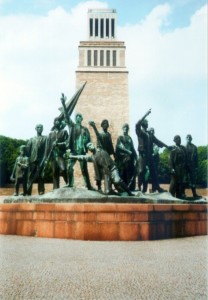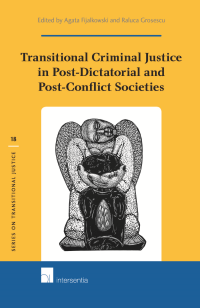Contested Nazi Victimhood after 1989
Posted on 23 September, 2015 in1989 Communism Fall of the Berlin Wall Memory Post Socialism Post-Soviet Countries Rethinking 1989 Socialism

By Nelly Bekus
International Day of Liberation of Nazi Concentration Camp Inmates and its Geopolitical Implications
The date 11th of April is marked by the Russian News Agency RIA as “International Day of Liberation of Nazi Concentration Camp Inmates.” According to RIA, “The International Day of Liberation was established to commemorate the international uprising of the Buchenwald concentration camp prisoners.” The Calendar of Events project—Calendar.ru, the most comprehensive resource on “holidays and memorial days” on Russian-language Internet, refers to April 11 as International Day of Liberation of Nazi Concentration Camp Inmates in two categories: in “Great Patriotic War” and as “International Days of Observance.” There is an article on this Day of Observance in Russian Wikipedia; it refers to RIA as a main source and even mistakenly claims that it was established by the UN. Information on International Day of Liberation of Nazi Concentration Camp Inmates, however, is not to be found in other languages anywhere except the Russian international news agency Sputnik, working in foreign languages (previously known as The Voice of Russia).
The piece of information provided by RIA serves as a starting point for hundreds of publications across the Russian and post-Soviet media that report on various remembrance events dedicated to the memory of victims of Nazi’s concentration camps taking place on this day. In Moscow, a memorial rally at Poklonnaya Hill is held at The Tragedy of the Peoples monument, erected in 1996 in the memory of former Nazi concentration camps’ inmates and constitutes an integral part of the Victory Memorial Park on Poklonnaya Hill in Moscow. Rallies are traditionally organized by the International Union of Former Juvenile Prisoners of Fascism. The Union was created in 1988 as the Union of Former Juvenile Prisoners in Soviet Union; in 1992 it was reinvented as the International Union, which provided platform for cooperation between analogous national Unions within the former Soviet space. In fact, the April 11 has been observed in those states, where national and local branches of this International Union function. Attended by former Nazi concentration camp inmates and their descendants these memorial meetings have profound public appeal due to the engagement of educational and cultural institutions and media coverage. Commemorations on the April 11 have been widely supported by local government; ceremonies are attended by top officials, with the exception of Baltic countries, where the remembrance events on the April 11 are supported by Orthodox Church instead.
Alongside the rallies, there are traditional ceremonies of flower-laying at the monuments and memorial sites dedicated to the former Nazi camps’ prisoners held across the regions, and also concerts in memory of victims, “lessons of heroism” at schools, various dedicatory exhibitions and meetings in public libraries and museums are organized across Russia and other post-Soviet states. Governmental educational resources provide variety of supporting materials such as proposed scenario for the “lessons on heroism,” suggested literature, etc. In a way, this informational support is analogous to what can be found on the United Nations webpage with educational materials and information products recommended for the observance of the International Day of Commemoration in Memory of the Victims of the Holocaust on the January 27, established by UN in 2006. In fact, the status of April 11 in post-Soviet countries clearly creates the impression of maintaining a parallel memory on the former inmates of Nazi’s concentration camps.
Between Auschwitz and Buchenwald
The symbolism of the date—the day of liberation of Buchenwald camp on April 11, as opposed to January 27, the day of liberation of the Camp of Auschwitz chosen by UN—appears to have special meaning in commemoration of victims of Nazi regime. This symbolism goes back to the initial stage of memorial work in the early post-war years. The history of the Buchenwald’s liberation compiled by RIA agency and reproduced every year in numerous post-Soviet media on the April 11 tells the story of heroic uprising of the Buchenwald concentration camp inmates:
“65 years ago, on April 11, 1945, a red flag was hoisted over the Buchenwald camp administrative building. On that day the inmates disarmed and took prisoner more than 800 SS-men and camp guards […]
Two days later US troops reached Buchenwald.”
This concise story mentions only shortly “the red flag” raised by underground rebels and fails to mention that the resistance was organized mostly by Communists. Similarly politically neutral narration can be found on the webpage of Buchenwald Museum: “April 11. The SS flees, but before the fighting is over, inmates of the camp resistance occupy the tower and take charge of order and administration in the camp.”
Evidently, communists’ involvement in the underground resistance at Buchenwald lost its appeal in contemporary perspective. Nevertheless, immediately after the war this fact was not only recognized but also effectively used in promotion of corresponding memory narrative on the struggle of communist antifascists against Nazis. The camp was perceived as a symbol of political victims who were also heroic fighters and played essential role in memorialization of the Second World War among anti-fascist in many European countries. Buchenwald’s key role in the formation of international memory of former concentration camps’ inmates was officially confirmed in 1948, when the International Federation of Former Political Prisoners (FIAPP) declared the April 11 as “The International Day of Former Political Prisoners” and “The International Day of the Deportees.” Later it was renamed into the “Day of International Solidarity of Liberated Political Prisoners and Fighters” by the successor of FIAPP—International Federation of Resistance Fighters (FIR). In those days, April 11 was a day with profound international anti-fascist connotation, which could be proudly communicated across the East-West divide. With the beginning of Cold War and the rising tensions between the Western and Eastern blocs, the political prisoners’ organization, such as FIAPP/FIR, lost their influence in the West. Buchenwald memory and the symbolism of April 11 were gradually reduced to the communist milieu.
In GDR, Buchenwald was entitled the role of major pantheon to heroic resistance fighters and the “self-liberation” of the camp became the focus of a memorial complex (1958). Buchenwald, a site of official pilgrimage and ceremonies, stood for antifascism and to some extent was called to instil pride. Memory narrative developed on the Eastern side of the Iron Curtain, which preferred to commemorate Communist “fighters” rather than Jewish “victims.” On the other side of the Berlin Wall, the association between communist ideology and post-war antifascist discourse in communist countries resulting in the marginalization of Holocaust made it easier for Western Allies to listen to the voice of victims of racial persecution, above all Jews. For them, it was Auschwitz that became the symbol of Nazi crimes as well as collective shame and guilt.
In the context of Cold War, the politicization of memorial work on the other side of the Iron Curtain was combined with the corresponding political line. Communist states combined it with anti-Western political propaganda; the Alliance and other anti-communist organizations merged honoring of Nazism’s victims with the pursuit of their own political agenda: comparing Stalinism with Nazism did more than condemn Communism; it also downplayed the uniqueness of the Nazis’ regime.
It was at that time, in 1950, when also the term “victims of fascism” was discarded by Philipp Auerbach for its communist connotations and proposed to replace it with “victims of Nazism.” Since then, the previously common enemy was even to be named by former Allies differently.
After 1989: An Unsuccessful Memory Unification
The Fall of the Berlin Wall in 1989 brought a hope that the memory of World War II could provide a solid ground for overcoming Cold War’s divisive legacy. In the 1990s it seemed fairly possible that integration of the “Western” and the “Eastern” perspectives into a common paradigm of remembering could become one of the building bricks in a new European home.
Some changes in the memory politics of the post-Soviet Russia and CIS countries have, indeed, occurred. The memory of Jewish genocide was given more consideration as a part of war story in the territory of former Soviet Union than previously. The real unification of European and post-Soviet memory spaces, however, has never been achieved. Instead, political transition in former socialist states and the reconfiguration of EU borders resulted in a formation of new symbolic mapping of memory.
In the European history of remembering the victims of the Second World War, the focus on Holocaust was transformed, as Aleida Assmann noted, “into a transgenerational and transnational memory.” Shared memories of Holocaust were capable of uniting European countries in commemorating its victims and teaching next generation of Europeans the history lesson, becoming a foundation myth for united Europe and a moral yardstick for new member states since 2005. Commemoration of the Holocaust victims came to be one of unifying rites called to manifest the common efforts in creation of Europe as a remembering community. In 2005, European Holocaust Memorial Day across the EU was established on January 27. The same year and for the same date the General Assembly of UN established annual International Day of Commemoration in Memory of Victims of the Holocaust. Even though in some calendars of several former socialist states one can still find “Day of International Solidarity of Liberated Political Prisoners and Fighters” mentioned with the reference to Buchenwald liberation, no commemorative activity has ever been reported on this day outside post-Soviet space.
Many post-Soviet countries also join UN commemorations of the Holocaust victims. None of them, however, has the Commemoration Day included into the official calendar of observance days. In Russia and other post-Soviet countries this day has been observed by Jewish national organizations, foreign diplomatic missions and has, as a rule, semi-official status. Several attempts have been made to include commemoration of Holocaust into the official calendar of Russian state which has considerable Jewish community: in 2001, by the foundation “Holocaust”; in 2008 by the Federation of Jewish Communities of Russia; in 2012 by the Russian Jewish Congress; in 2013 by a Russian opposition party “Just Russia.” None of these initiatives, however, has been successful.
The day of 27th of January has been widely commemorated by national and religious Jewish organizations of Russia, often with the participation of Russian top officials. The president of Russia often takes part in these observances, but the mode and the context of such commemoration clearly marks the space of the Holocaust memory as a matter of one of Russia’s religious and national minorities. In 2010, Dmitry Medvedev, the then President of Russia, sent his greetings to participants in the ceremonies commemorating the 65th anniversary of the liberation of the Auschwitz-Birkenau concentration camp. In his address, Medvedev urged not forget that along with six million people that “were killed simply because of their ethnicity, simply for being Jewish,” there were other victims, too, because “according to the Nazis’ plan, at least a third of the population in the occupied territories was to follow their fate.” This attention to “other victims” of Nazi’s genocide in Medvedev’s address, as well as keeping the status of International Holocaust Remembrance Day as a matter of one of Russian Federation’s national minorities reveal an unarticulated intention to keep the weight of the “Jewish aspect” in the post-Soviet memory of the Second World War under controlled balance. It displays the post-Soviet determination to prevent total re-writing of the Soviet-originated narrative of the history of Second World War and the re-casting the memory on its victims in accordance with “Western” mode. And while Jewish communities in Russia join worldwide commemoration of January 27 as International Holocaust Remembrance Day, in the calendar of Russian state, January 27 is also marked as a date commemorating the end of Leningrad siege (established in 1995).
Reshaping a Divided Victimhood
Surely, in contemporary conditions the division lines in the memory sphere work differently. Disregarding Holocaust in post-Soviet countries proves to be both impossible and unreasonable and Jewish communities across the former Soviet space observe the Memory of Holocaust on January 27. Emphasis on Holocaust, however, conveys implicit meaning of being “Western interpretation” of Nazi’s victimhood. And revitalization of public commemorations on April 11 in post-Soviet states clearly demonstrates that the once envisaged “unification” of divided victimhood is not going to be achieved by one-sided acceptance of the “Western” memory perspective by the former “East”. Along with the “Europeanization of the memory boom” denoted by rising significance of Holocaust Remembrance Day on January 27, the official memory politics in post-Soviet countries sought to establish alternative commemoration which would meet the needs and wishes of the majority of former Soviet people. April 11 was assigned this role of the post-Soviet parallel to the European Commemoration of Holocaust which allows to maintain “other” perspective on the “victimhood of fascism” alongside the memory of Holocaust. Buchenwald as a symbolic alternative came almost naturally to fit this new memory practice demand. Buchenwald camp was widely known to the Soviet people. Due to a popular patriotic song “Buchenwald alarm bells,” it was part of the official canon of the Soviet cultural war memory.
April 11 reiterates in many respects the idea of commemoration of Holocaust victims—but it avoids stressing the ethnic genocide of Jews or any other particular ethnic group. Every publication on commemoration of the Liberation of Nazi Concentration Camp Inmates speaks, instead, about 5 million of Soviet people among 19 million of Nazi camps’ prisoners; in some cases, 6 million of Jewish victims are mentioned, too.
On the one hand, recalling the memory of the Soviet victims among prisoners of Nazi’s concentration camps in public commemorations and rituals held on the April 11 can be read as the efforts to maintain post-Soviet space as a “remembering community.” On the other hand, persistent emphasis on the international status of this day is also telling. Nations that once belonged to USSR today represent international community aspiring to be an actor on the geopolitical memory arena. At the same time, talking about any long-established history of April 11 as an International Day of observance refers to the “internationalism” characteristic for post-war political anti-fascism and resistance fighters. And while communist ideology that once constituted the core of that movement became irrelevant and marginal, its internationalist appeal remains meaningful. Bridging these two aspects in the commemorative practices on April 11 makes possible the prevention of the post-Soviet space of commemoration of victims from segregation and isolation, at least symbolically.
This relatively new memorial date can be interpreted as a signifier in the geopolitics of memory coming to replace political ideologies, which constituted inseparable feature of the memorial work in the Cold War realm. It shows how geopolitical entities have been re-constituted and united anew, while the process of re-shaping memories attendant upon the end of Cold War remains embedded in the divisions of the past.
Original is published by Aspen Review
http://www.aspeninstitute.cz/en/article/3-2015-contested-nazi-victimhood-after-1989/
Global Socialism and Post Socialism Workshop Report
Posted on 8 July, 2015 in1989 after 1989 Globalisation Post Socialism Rethinking 1989 Socialism

Held May 13, 2015 at The University of Exeter
Report by James Mark, Nelly Bekus, Anna Calori, Raluca Grosecu, Ned Richardson-Little, and Ljubica Spaskovska
While the topic of globalization has emerged as rapidly growing field in recent years, the role of the socialist world is often neglected or seen as passive or unengaged in these processes. This workshop, hosted by 1989 after 1989: Rethinking the Fall of State Socialism in Global Perspective research group, sought to challenge these narratives by examining the myriad engagements of the socialist world with the global. The presentations proposed new methodological and theoretical means of grappling with how late socialism fits into the larger narrative of globalization, examined the spaces in which processes of globalization occurred in the socialist world, and analyzed the long-term effects of these developments after 1989 and the collapse of state-socialism.
 Tobias Rupprecht (University of Exeter) opened the first panel – Approaches to Globalisation and The Socialist World – providing a broad introduction to the themes of the workshop. He explored how current literature on globalisation is still often shaped by the values of the 1990s, and how, within this, the socialist world is most commonly presented simply as a victim of globalising forces. He then demonstrated the various ways in which the socialist world provided templates for ‘alternative globalisations’, and also acted as co-producer of some of the aspects of the globalised world we experience today.
Tobias Rupprecht (University of Exeter) opened the first panel – Approaches to Globalisation and The Socialist World – providing a broad introduction to the themes of the workshop. He explored how current literature on globalisation is still often shaped by the values of the 1990s, and how, within this, the socialist world is most commonly presented simply as a victim of globalising forces. He then demonstrated the various ways in which the socialist world provided templates for ‘alternative globalisations’, and also acted as co-producer of some of the aspects of the globalised world we experience today.
 Bogdan Iacob (New Europe College, Bucharest) presentation – Negotiating the National. Romania, Globalization, and International Congresses of Historical Sciences (1970-1980) – analysed the responses of the Romanian socialist government to the rising web of interdependencies in 1970s, which would come to be known as globalization in the next decade. He then tested the implementation of this position for the case of the country’s engagement with International Congresses of Historical Sciences, particularly those between 1970 and 1980 – in Moscow, San Francisco, and Bucharest. Focusing on the Bucharest conference of 1980, the Iacob argued that one can identify a dichotomous approach to globalization in the case of Romania. On the one hand, the country was fully engaged with supra-, inter-, and non- governmental institutions during the global Cold War. On the other hand, the internationalization of Romanian state socialism also meant showcasing components of local modernity. The presentation underlined that the Romanian case of socialism going global is a cautionary tale. It is the story of a regime engrossed in the global encounters of the 1960s and 1970s that reaches, in 1980s, a final phase of systemic insulation and exacerbated essentialism. For the local, state socialist globalization ultimately meant carving pericentric frameworks highly dependent into very specific Cold War contexts.
Bogdan Iacob (New Europe College, Bucharest) presentation – Negotiating the National. Romania, Globalization, and International Congresses of Historical Sciences (1970-1980) – analysed the responses of the Romanian socialist government to the rising web of interdependencies in 1970s, which would come to be known as globalization in the next decade. He then tested the implementation of this position for the case of the country’s engagement with International Congresses of Historical Sciences, particularly those between 1970 and 1980 – in Moscow, San Francisco, and Bucharest. Focusing on the Bucharest conference of 1980, the Iacob argued that one can identify a dichotomous approach to globalization in the case of Romania. On the one hand, the country was fully engaged with supra-, inter-, and non- governmental institutions during the global Cold War. On the other hand, the internationalization of Romanian state socialism also meant showcasing components of local modernity. The presentation underlined that the Romanian case of socialism going global is a cautionary tale. It is the story of a regime engrossed in the global encounters of the 1960s and 1970s that reaches, in 1980s, a final phase of systemic insulation and exacerbated essentialism. For the local, state socialist globalization ultimately meant carving pericentric frameworks highly dependent into very specific Cold War contexts.
The second panel – The Socialist World, Trade, and Globalisation – began with James Mark’s  (University of Exeter) presentation, “Between the Eastern Bloc and the East Asian ‘Tigers’: The Opening Up between Hungary and South Korea 1970-1995.” Mark used the opening up between Hungary and South Korea to explore the ways in which experts in a socialist state imagined the operation of the world economy in the late Cold War. He showed how reform economists in Hungary, influenced by World Systems Theory, re-imagined their country’s role in the world economy as semi-peripheral. This then led them to an interest in the Asian “Tigers” as examples of successful integration into the world economy by formerly semi-peripheral countries. He explored these experts’ new prescriptions for the Hungarian economy from this perspective, and the fascination with South Korea amongst political and economic elites in the last years of state socialism.
(University of Exeter) presentation, “Between the Eastern Bloc and the East Asian ‘Tigers’: The Opening Up between Hungary and South Korea 1970-1995.” Mark used the opening up between Hungary and South Korea to explore the ways in which experts in a socialist state imagined the operation of the world economy in the late Cold War. He showed how reform economists in Hungary, influenced by World Systems Theory, re-imagined their country’s role in the world economy as semi-peripheral. This then led them to an interest in the Asian “Tigers” as examples of successful integration into the world economy by formerly semi-peripheral countries. He explored these experts’ new prescriptions for the Hungarian economy from this perspective, and the fascination with South Korea amongst political and economic elites in the last years of state socialism.
With his presentation, “Trading Internationalism: Rethinking Cold War Narratives through Sino-Middle East Relations, 1950s-70s,” Sam Zhiguang (University of Exeter) challenged the idea that international trade should be conceptualized solely in terms of commercial value. He argued that both Western economic models of comparative advantage or concepts such as Socialist division of labour did not capture the ideological and cultural meaning of trade in the People’s Republic of China during the Cold War. According to Chinese doctrine, establishing international unity was essential to national unity. One of the key means of fostering solidarity with the Third World was through the exchange of trade delegations. Through the lens of Sino-Middle East relations, he contended that while these exchanges did not often lead to significant commercial activity, this was not their primary goal. Chinese enthusiasm for engagement with the Middle East was not motivated by profit, but a more complex ideological understanding of global unity as a proxy for the wellbeing of China itself under Communist rule.
Anna Calori’s (PhD student, University of Exeter) presentation titled “Privatisation Reforms and the Global Market: Fragmenting the Workforce in Late-Socialist Bosnia-Hercegovina” explored the rationale behind the late 1980s economic reforms in Yugoslavia and their disruptive effects within the workplace of large, exporting companies. Engaging with primary sources such as factory bulletins and internal journals, Calori provided an analysis of discourses and debates around what was presented as a necessary change in the Yugoslav economic model of workers’ self-management. Responses to the urgencies of competitiveness on the global market meant a re-conceptualisation of the (post) socialist worker based on new exclusionary categories of merit and efficiency. This deeply affected the industrial workplace, exacerbating the already existing skills divisions and allowing for a further fragmentation of the workforce in the critical moments leading to Yugoslavia’s disruption.
Calori’s (PhD student, University of Exeter) presentation titled “Privatisation Reforms and the Global Market: Fragmenting the Workforce in Late-Socialist Bosnia-Hercegovina” explored the rationale behind the late 1980s economic reforms in Yugoslavia and their disruptive effects within the workplace of large, exporting companies. Engaging with primary sources such as factory bulletins and internal journals, Calori provided an analysis of discourses and debates around what was presented as a necessary change in the Yugoslav economic model of workers’ self-management. Responses to the urgencies of competitiveness on the global market meant a re-conceptualisation of the (post) socialist worker based on new exclusionary categories of merit and efficiency. This deeply affected the industrial workplace, exacerbating the already existing skills divisions and allowing for a further fragmentation of the workforce in the critical moments leading to Yugoslavia’s disruption.
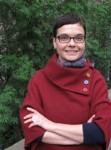 In the third panel, “Spaces of Globalisation in Eastern Europe” Ljubica Spaskovska (University of Exeter) examined “Socialist global citizenship: the case of Yugoslavia.” Spaskovska’s presentation addressed a range of “spaces” of global encounters and cooperation through the lens of “global citizenship.” In different ways related to the United Nations, the Non Aligned Movement, the International Centre for Public Enterprises in Developing Countries and the post-1963 earthquake development plan for Skopje were some of those spaces of global citizenship where ideas that revolved around (equitable) development, anti-colonialism, fairer terms of trade and fostering ‘active peaceful coexistence’ gained ground. Socialist Yugoslavia’s “globally imagined citizenship” was a chartered foreign policy course that produced an impressive record of economic, intellectual and cultural exchange and enabled the country to vie for influence and recognition in a divided world. Although often discordant, the Non Aligned Movement managed to carve out alternative spaces and put forward novel development agendas and paradigms of international cooperation.
In the third panel, “Spaces of Globalisation in Eastern Europe” Ljubica Spaskovska (University of Exeter) examined “Socialist global citizenship: the case of Yugoslavia.” Spaskovska’s presentation addressed a range of “spaces” of global encounters and cooperation through the lens of “global citizenship.” In different ways related to the United Nations, the Non Aligned Movement, the International Centre for Public Enterprises in Developing Countries and the post-1963 earthquake development plan for Skopje were some of those spaces of global citizenship where ideas that revolved around (equitable) development, anti-colonialism, fairer terms of trade and fostering ‘active peaceful coexistence’ gained ground. Socialist Yugoslavia’s “globally imagined citizenship” was a chartered foreign policy course that produced an impressive record of economic, intellectual and cultural exchange and enabled the country to vie for influence and recognition in a divided world. Although often discordant, the Non Aligned Movement managed to carve out alternative spaces and put forward novel development agendas and paradigms of international cooperation.
 In Ned Richardson-Little’s (University of Exeter) paper “Where the World Meets”: Globalization and Socialism at the Leipzig Trade Fair,” he examined the paradoxes of East Germany’s engagement with the world through the lens of famous Leipziger Messe. While the trade fair was supposed to serve as a site of cooperation fostering East-West understanding and exchange between “the two world systems,” it was also to serve as the “show-window of socialism” and demonstrate the superiority of the Socialist Bloc over its Western counterparts. The Trade Fair initially acted as a proxy site of diplomatic and cultural contact with the world while East Germany remained diplomatically unrecognized outside the Socialist Bloc. Later, the Trade Fair acted as a crucial venue for GDR efforts to integrate into the modernizing global economy in the 1970s and 1980s through joint ventures with the West and Third World export deals. While the Trade Fair was a gateway to the benefits of globalization, it was also a site of dangerously uncontrolled contact for East Germans to the outside world, which contributed to the political destabilization of the 1980s.
In Ned Richardson-Little’s (University of Exeter) paper “Where the World Meets”: Globalization and Socialism at the Leipzig Trade Fair,” he examined the paradoxes of East Germany’s engagement with the world through the lens of famous Leipziger Messe. While the trade fair was supposed to serve as a site of cooperation fostering East-West understanding and exchange between “the two world systems,” it was also to serve as the “show-window of socialism” and demonstrate the superiority of the Socialist Bloc over its Western counterparts. The Trade Fair initially acted as a proxy site of diplomatic and cultural contact with the world while East Germany remained diplomatically unrecognized outside the Socialist Bloc. Later, the Trade Fair acted as a crucial venue for GDR efforts to integrate into the modernizing global economy in the 1970s and 1980s through joint ventures with the West and Third World export deals. While the Trade Fair was a gateway to the benefits of globalization, it was also a site of dangerously uncontrolled contact for East Germans to the outside world, which contributed to the political destabilization of the 1980s.
 The fourth panel on “Global Socialism and Its Legacies” began with Raluca Grosescu (University of Exeter) presenting on “International Criminal Law Before and After 1989: The Case of the UN Convention on the Non-Applicability of Statutory Limitations to War Crimes and Crimes against Humanity.” Grosescu examined the role of state-socialist countries in the development of international criminal law, through the example of the 1968 UN Convention on the Non-Applicability of Statutory Limitations to War Crimes and Crimes against Humanity. She examined the context, the negotiations, and the interpretations that had been given to the Convention in 1968 and then focused on the Convention’s application and its new readings in domestic prosecutions of human rights abuses in Argentina and Estonia in the 2000s. Grosescu argued that international criminal law norms initiated or supported by state-socialist countries during the Cold War have been highly instrumental in trials dealing with crimes of authoritarian regimes during the “third-wave of democratization” in Latin America and Eastern Europe. The presentation also reflected on the historicity of law by examining how legal norms constructed in a particular historical context with a specific political purpose are re-interpreted and re-negotiated in order to fulfil new political goals in the present.
The fourth panel on “Global Socialism and Its Legacies” began with Raluca Grosescu (University of Exeter) presenting on “International Criminal Law Before and After 1989: The Case of the UN Convention on the Non-Applicability of Statutory Limitations to War Crimes and Crimes against Humanity.” Grosescu examined the role of state-socialist countries in the development of international criminal law, through the example of the 1968 UN Convention on the Non-Applicability of Statutory Limitations to War Crimes and Crimes against Humanity. She examined the context, the negotiations, and the interpretations that had been given to the Convention in 1968 and then focused on the Convention’s application and its new readings in domestic prosecutions of human rights abuses in Argentina and Estonia in the 2000s. Grosescu argued that international criminal law norms initiated or supported by state-socialist countries during the Cold War have been highly instrumental in trials dealing with crimes of authoritarian regimes during the “third-wave of democratization” in Latin America and Eastern Europe. The presentation also reflected on the historicity of law by examining how legal norms constructed in a particular historical context with a specific political purpose are re-interpreted and re-negotiated in order to fulfil new political goals in the present.
 In her presentation on “Soviet Frames of Global Experience in Architecture, Before and After 1989,” Nelly Bekus (University of Exeter) argued that both architecture and urban planning were considered to be a powerful instrument in cold war politics. The presentation examined the specific frameworks of the concept of Soviet internationalism, which mentally mapped the world beyond the ideological blocs. Specific educational and professional conditions and practices elaborated for architects in the USSR meant to produce such mental representation of the Soviet Union territory that made it fully operational and sufficient for self-perception of Sovietness as a form of global identity. Bekus also discussed International Architectural Design competitions as a space of global engagement of architects beyond the Soviet borders. These competitions often served as stages of “global professionalism” for architects and in which Soviet participants could claim their part.
In her presentation on “Soviet Frames of Global Experience in Architecture, Before and After 1989,” Nelly Bekus (University of Exeter) argued that both architecture and urban planning were considered to be a powerful instrument in cold war politics. The presentation examined the specific frameworks of the concept of Soviet internationalism, which mentally mapped the world beyond the ideological blocs. Specific educational and professional conditions and practices elaborated for architects in the USSR meant to produce such mental representation of the Soviet Union territory that made it fully operational and sufficient for self-perception of Sovietness as a form of global identity. Bekus also discussed International Architectural Design competitions as a space of global engagement of architects beyond the Soviet borders. These competitions often served as stages of “global professionalism” for architects and in which Soviet participants could claim their part.
In opening the concluding discussion, Angela Romano (University of Glasgow) underlined the importance of combining a micro- and a macro perspective, which would in turn shed light on the range of networks and the contribution of the socialist world to the processes of globalisation. She emphasized the importance of re-integrating 1989 into the study of the alternative spaces of globalization – not necessarily as a turning point, but as an opening for the debate about different forms and practices of global engagements that shaped both the socialist and the post-socialist world.
Workshop Overview
Panel 1: Approaches to Globalisation and The Socialist World
Dr Tobias Rupprecht (Exeter), The ‘Socialist World’ and ‘Global History’
Bogdan C. Iacob (New Europe College, Bucharest), Politics of National Identity as Mechanism of Globalizing Late State Socialism
Panel 2: The Socialist World, Trade, and Globalisation
Professor James Mark (Exeter), Between the Eastern Bloc and the east Asian ‘Tigers’: The Opening Up between Hungary and South Korea 1970-1995
Dr Sam Zhiguang (Exeter), Trading Internationalism: Rethinking Cold War Narratives through Sino-Middle East Relations, 1950s-70s
Anna Calori (PhD, Exeter), Privatisation reforms and the global market: fragmenting the workforce in late-socialist Bosnia-Hercegovina
Panel 3: Spaces of Globalisation in Eastern Europe
Dr Ljubica Spaskovska (Exeter), Socialist Global Citizenship: The Case of Yugoslavia
Dr Ned Richardson-Little (Exeter), “Where the World Meets”: Globalization and Socialism at the Leipzig Trade Fair
Panel 4: Global Socialism and Its Legacies
Dr Raluca Grosescu (Exeter) International Criminal Law Before and After 1989: The Case of the 1968 UN Convention on War Crimes and Crimes against Humanity
Dr Nelly Bekus (Exeter) Soviet Frames of Global Experience in Architecture, Before and After 1989
Concluding Discussion
with comments from Dr Angela Romano (University of Glasgow)
[Top]
Socialism Goes Global: Alternative Global Geographies Call for Papers
Posted on 8 June, 2015 inSocialism

Alternative Global Geographies, Imagining and Re-Imagining the World Late 19th Century – Present Day
Call for Papers for the Conference of the Research Network Socialism Goes Global
12 – 14 November 2015
Call for Papers Deadline: 27 July 2015
In contrast to public claims of the early 1990s, space and geographies have not lost their central role in defining an ever more globalized world. We still live in territorialized spaces: not only in the narrow sense of states and societies that reside within their borders, but also geographies and spatial formats on regional and world scales. Research in the aftermath of the spatial turn in the humanities and social sciences is increasingly drawing our attention to the importance of understanding large-scale spatial dynamics for global history.
Many influential paradigms, often emerging from metropolitan cores or centres of the Cold War, have emerged to make sense of an increasingly interconnected world. These have included Euro- and other ‘centric’ centre-periphery models, the idea of the Anglophone or Francophone worlds, the tricontinental model, World Systems Theory, or the division of the globe into the First, Second, and Third Worlds, or the ‘Global North and South’. Such ideas came not only from the academy (in e.g. geography, area studies, history, economics, anthropology) but also from the work of political, economic and cultural actors. This conference will explore such attempts to make sense of the world on a regional or global scale, and explore how such ideas have been used to make sense of, and organize, power relations, cultural encounters and economic connections.
We wish in particular to encourage papers focussing on the ‘view from the periphery’. Despite the recent turn to studying global history from non-western perspectives, there is still little research done on visions of world order from other actors outside metropolitan cores or the West- from e.g. Latin America, South and Eastern Asia, Eastern Europe, and Africa. We invite contributions dealing with ways of conceptualising the world from areas that thought of themselves as peripheral (or semi-peripheral) on a global scale, or, indeed, challenged their definition as such. We wish to emphasise that we do not set an a priori definition of ‘periphery’ – the definition of where the periphery is located, how it is defined and who belongs to it shall be rather an element of the analysis. We also encourage contributions on those who conceptualised alternative visions of world orders, from a variety of political, religious, cultural or economic movements – regardless of their geographical location (i.e. also from critical or peripheral standpoints within the metropole/ core).
The event aims to bring together scholars from multiple disciplines (e.g. history, sociology, geography, anthropology and others), working on various topics (colonialism, post-colonialism, socialism and radicalism), on different world regions or on a world scale. The time frame may range from the late 19th century – as an era in which global imaginations and political projects of a politico- and cultural-spatial organization of the world powerfully emerged in relation to late colonial regimes – through the transformations of the interwar, the Cold War and decolonisation, and up until the present day.
Papers might address:
– conceptualizations and spatializations of the world: how have actors accepted or critiqued dominant visions of global spatial visions; what ‘alternative visions’ have been proposed e.g. ‘socialist world’, ‘anti-imperialist world’, ‘Afro-Asian world’, ‘global South’, ‘majority world’; how have actors worked to make such reconceptualisations authentic, or new interconnections a reality?
– the relation between political projects and practices to these conceptualizations – either as producers of these or through instrumentalizing them.
– the clashes between such conceptualizations and practices, paying attention to the web of power relations inherent in these conflicts.
– the roles of expert cultures (e.g. area studies institutes, agricultural specialists, economists, sociologists, fiction writers) and non-academic actors (e.g. activists); institutionalisations based on spatial imaginaries; the intellectual production of spatialized knowledge; the role of trans-regional exchange in the production of spatial models.
– the production of authenticity in new geographical imaginaries (how have these new imaginaries been made real? How have imagined distances between world regions been collapsed, or new borders and frontiers between world regions produced? How and why have alternative visions failed in the face of dominant models?).
– the conceptualisation of the periphery and semi-periphery (how did actors relate themselves to the concept? How did internal peripheries within regions or countries shape how actors conceptualised peripheries on a global scale?).
– relations between ideological camps and geographical spaces (e.g. imperialism, anti-imperialism and spatialized visions; shifting and rival definitions of the globe as a set of large geocultural units by the Cold War powers; contested visions of world mapping).
– the role of world mapping in domestic cultures in different ideological systems and regional settings (e.g. political uses; global spatial mappings as ‘disciplining tools’ for home populations; representations of world orders in e.g. maps, culture, political discourse; the political and cultural interpreters of spatialized visions for popular audiences).
Please send a brief abstract of 300-500 words, as well as a brief CV, by 27 July 2015, to Catherine Devenish at the University of Exeter (C.Devenish@exeter.ac.uk ). The conference will take place in Leipzig from 12 to 14 November 2015. Some funding opportunities for travel and accommodation are available, but we ask that potential contributors explore funding opportunities at their home institutions.
[Top]Workshop on Global Socialism and Post Socialism
Posted on 13 April, 2015 in1989 after 1989 Socialism

13 May 2015
The University of Exeter, Amory A239AB
Time: 9am – 6.15pm
All are welcome to attend our workshop on Global Socialism and Post Socialism which will be held on Wednesday 13 May, 2015 here at the University of Exeter. The theme of the one day workshop will be global socialism/ post-socialism and will include papers from the 1989 after 1989 Research Team and a number of invited speakers.
Papers will cover: re-conceptualising globalisation and the socialist world; the encounter between eastern Europe and the east Asian ‘tigers’ in the late Cold War; eastern European trade fairs as sites of global encounter in the Cold War; China and the idea of trade with ‘Third World’ and Yugoslavia and African engagements.
For more information about this event and to see the programme for the day please visit our Workshops page.
[Top]Minsk as a Townscape of The Belarusian Power
Posted on 25 February, 2015 in1989 after 1989 Post-Soviet Cities

By Nelly Bekus
Cityscape of Minsk embodies the imaginary environment of the Belarusian power as a legitimate successor of the socialist state.
“If Soviet cities had looked like Minsk today, Soviet Union would have survived,” is probably one of the most indicative opinions I’ve ever heard from the visitors of the Belarusian capital. It is rather problematic to say to which extent it captures the hypothetical fortune of the Soviet state, but what it certainly does is reveal aspirations that inform the capital formative politics of the Belarusian leadership.
Any state can be viewed as a performative collective actor, which both reproduces and has been reproduced through banal processes, which enforce the symbolic presence of state across all kinds of social practices and relations and which help to sustain connection between the state and the people via the concept of belonging. Any capital city is assigned a particular role in displaying and channeling the nation’s image and idea. Yet, in country like Belarus the pressure on capital’s symbolic importance not even doubles, but triples. The country’s newborn national statehood, its centralized political system, and its vastly meaningful socialist legacy, material and non-material alike, facilitate maintaining the hegemony of power in various spheres of peoples’ life. Belarus turned to be particularly apt to preserve and develop the Soviet pattern of the symbolic-ideological design of state, reproducing the matrix of the “spectacular state” in the nationstate framework. A wide range of various civil rituals and social practices has been developed on the micro- and macro-levels of everyday life of the Belarusians, which aim at symbolic reification of the Belarusian idea, as understood by ideologists. Minsk, no doubt, has been assigned a particular role in the performative strategy of the Belarusian state.
Favourable National Framework for the Socialist Legacy
After the failure of state socialism the capital cities of the new independent states had to formulate new principles of their urban development. For many countries, the model to follow became the “Western city,” as an attribute of European civilization, the winner of the Cold War. The consequences of cities’ development in that direction (socio-spatial stratification, suburbanization, gentrification, automobilization, etc.) were perceived as natural and even desirable products of the changing pattern of urbanism. The socialist legacy of cities associated with the outdated system came to be perceived as unwanted inheritance. Micro-districts that once embodied the idea of egalitarian society have now become the most decaying areas in cities.
Against this background, Minsk appears to be a rare exception. The status granted to its socialist legacy in the new national cityscape and the logic of its cooperation with the nation-state ideology puts Belarus outside of Eastern European liberal affinity. The primary metaphor of the Belarusian official discourse defining post-communism has become the idea of a seamless continuation of the Soviet tradition. From the beginning of his presidency, the Belarusian President A. Lukashenko has chosen strategy of exploiting the nostalgic feelings of one part of Belarusian society, and he did so for a good reason. The last decade of the state socialism often depicted as “Soviet decay” seemed contrary to the lived experience of most Belarusians. It was not stagnation, but the years of rapid economic development and improvement of the lifestyle of the majority.
Minsk as a Soviet Artefact
The major structural changes in Belarus took place after the Second World War. Minsk as the capital of the Republic of Belarus was also the product of Soviet vintage. Minsk experienced massive destruction during the Second World War, it was the third most demolished city after Berlin and Warsaw. 80% of city infrastructure and 70% of pre-war housing stock of the city were destroyed.
According to the conception of master plan of Minsk (1946), new city was designed to combine the image of a “true capital of the Soviet Socialist republics” with the function of a large industrial center. The combination of striking parade monumentalism, patriotic art decoration and traditional motifs has become the most characteristic feature of the central avenues of Minsk. In late 1950s, when quasi-pragmatic period of socialist architecture had begun with its shift to the wide use of standardized construction, the center of Minsk had been surrounded by a belt of simplistic buildings made of pre-fabricated concrete, gradually passing into the clone-like “sleeping areas” of late socialism. The image of city soon became dominated by buildings that provided modest accessible housing for everybody due to a rapid construction of classless neighborhoods.
In the 1960s, when the construction of the monumental image of the city center was almost complete, Soviet authorities undertook an action for the ideological design of Minsk. A mythology of the partisan movement as the specific “Belarusian” contribution to a common victory in the Great Patriotic War became a key element of the Soviet Belarusian historical narrative, immediately reflected in a corresponding symbolization of public spaces in Minsk. The status of “Hero City” was given to Minsk in 1974. In addition, several important monuments were dedicated to World War II: Victory square with the eternal flame in front of the obelisk in the city center; Yama Memorial (the Ditch), dedicated to the commemoration of 800 000 Belarusian Jews—victims of the Holocaust; and a memorial on the site of the Nazi concentration camp Trastsianets. The Belarusian Great Patriotic War Museum in Minsk became the first museum in Belarus, opened in 1944, even before the war was over. In 1966 it was relocated to Oktiabrskaya Square, next to the building of the Central Committee of Communist Party of BSSR (the Presidential Palace since 1994).
The mythology so attentively composed by Soviet ideologists for Belarusians outlived the Soviet state itself. It became a key element of the national narrative about heroic collective deeds. In contrast to the Soviet narrative, the new discourse nationalizes the Belarusians’ heroic fight against the Nazi occupiers during World War II. The emphasis has been put not on the fraternal struggle of Soviet people against invaders, but on the Belarusians’ effort in liberation of their land. In a similar fashion, the general perception of Sovietness has been “Belarussified.”The Soviet period is now described as a period of formation of the contemporary Belarusian nation.
The Soviet legacy, solidified and materialized in the center of Minsk, appears to be a fairly relevant reflection of the official view on the formation of the Belarusian nation. The Sovietness of Minsk’s city center has the same functional meaning of “historical heritage” that all European countries invest in their capitals. In old European cities the preservation of the historical center has meant the creation of a kind of reservoir of national cultural tradition, molded into architectural form. The history encoded in the architectural monumentality of the Stalinesque center of Minsk refers to the Soviet era, but it has been attributed the same symbolic meaning. In 2004, Belarusian authorities nominated Minsk’s central avenue for inclusion on the UNESCO World Heritage List (avenue’s name in Soviet times— Stalin Avenue, from 1961—Lenin Avenue, from 1991—Frantishak Skaryna Avenue, and, finally, since 2004 till present time—Independence Avenue). The cultural legacy, represented by the remarkably solid and stylistically homogeneous urban architectural ensemble of central Minsk, has been presented as evidence of the Soviet contribution to the formation of the Belarusian nation. In the spirit of this memory politics, not only have all Soviet monuments kept their place and symbolic meaning in Minsk’s public space (including the Lenin statue on Independence Square) but new monuments commemorating events and characters related to the Soviet past have also been built during the years since independence. A Feliks Dzierzhinski statue was installed in Minsk in 2006—a memorial to the founder of the Soviet NKVD, though there was a Dzierzhinsky monument in Minsk, built in the Soviet era near Independence Avenue. Several new monuments were built on the wave of the nationalization of the memory of World War II, such as the “Belarus Partizanskaya” (Partisan Belarus) monument that was built in 2004, and the memorial “Broken Hearth” dedicated to the memory of the victims of Nazism. New museum of the Great Patriotic War was opened in Minsk in 2014, which proposed a new version of the official war narrative, centered on Belarusians and their combined image of great victimhood and heroism.
The Ideological Concept and a Slight Shift
The symbolic domination of the Soviet legacy in the Minsk cityscape proves to be very consistent with the ideological concept of Belarus promoted by ruling elites. In those post-Soviet countries that developed liberal political regimes, any changes in the symbolic landscape of the capital cities reflect the struggle among the political elites for the “symbolic capital” embodied in and represented by places of memory (P. Bourdieu 1990). In Belarus, however, such a period of open contestation over the symbolic landscape of Minsk lasted only for four years from 1991 to 1994, and the changes made then did not affect the city’s existing monuments, though some changes did take place in the toponyms of Minsk. Although these changes were rather limited in scale (only 14 streets were renamed), they did affect key streets in the city center, effectively making visible the nationalization of the capital: the central Lenin Avenue was renamed after the leading Belarusian Renaissance scholar and humanist Francisk Skaryna, Lenin Square became Independence Square and Gorki (Russian writer) Street became Bagdanovich (Belarusian poet) Street. The Belarusian president corrected some of these changes in 2004, when he personally made a decision to rename two main thoroughfares, Skaryna Avenue and Praspekt Masherava as Independence Avenue and Avenue of the Victors. These changes were meant to indicate the authorities’ attention to the 60th anniversary of Victory Day in World War II and state independence, once again reasserting the role of war memory for national narrative of Belarus.
The political design of the Belarusian state that was established and has been successfully maintained by the incumbent president since 1994 does not allow for any alternative sources of power that could visibly affect the symbolic landscape of the Belarusian capital. Oppositional elites, deprived of any possibilities for influencing the cityscape, have very few instruments of symbolic resistance at their disposal. One avenue that is open to them is the use of educational historical initiatives, proposed by oppositional educational centers or individual historians. The weekly newspaper Nasha Niva regularly puts out information about“alternative” historical tours of Minsk, that have been created by oppositional historians as an alternative way to see Minsk and the history of Belarus (Addresses of Belarusian People’s Republic). Certainly, these kinds of educational and cultural initiatives cannot compete with the state machine’s work on the official ideological landscape of the city through the visual design of public spaces, monuments, and posters, as well as official mass events, etc.
In the 2000s, a slight shift in the ideological reading of the Soviet legacy could be noticed in the development of the capital cityscape. From presenting Sovietness as a period of significant Belarusian achievement it has moved to the idea of Soviet past as the foundation of an independent Belarusian state and one of the origins of its successes. New symbols of Belarusian independence have been constructed with the specific goal of demonstrating the successes of the current regime. Among them was the new modern railroad station (2004), the new National Library which quickly became an icon of the new Belarus (2006), and a three-level underground shopping mall, “The Capital”, situated under Independence Square (2007), which significantly transformed the function of the former Soviet city center by adding to it a consumerist attraction. Representative monumentality of Soviet Minsk was supplemented with a new icon of post-Soviet hegemonic power—the Palace of Independence (2013), adjacent to State Flag Square, with clear intention to emphasize the firmness of the Belarusian statehood.
At the same time, authorities became more attentive to the pre-Soviet history of Minsk: some destroyed fragments of pre-revolutionary Minsk were reconstructed, such as the 19th century town hall building, the Hotel Europe, and some others. This new development of the capital was backed by the ambitions of the president to make Belarus and its capital city a touristic attraction. “European” legacy in the Belarusian context, however, is not restored in order to return the country symbolically to Europe, but, on the contrary, to authorize Belarusian geopolitical choices by showing that “Europe” exists “inside” Belarus, therefore, there is not much need for Europe existing behind the western border.
New sport arenas and new hotels (Hotel Europe, Crowne Plaza) were constructed in order to prepare for the 2014 IIHF Ice Hockey World Championship. This event was unconditionally perceived by the authorities as a chance to demonstrate to the international community the achievements and successes of the country’s “third way” of development.
One of the elements of this third way is related to the ongoing tradition of constructing new residential areas—microdistricts—on the outskirts of Minsk. In most of the former socialist countries, system change meant a radical break with the image-making panel houses constructed in the city. In Belarus, on contrary, the housing policy preserved orientation towards the construction of state-subsidized affordable housing for people. As a result, new residential areas on the outskirts of Minsk have been constructed in the same manner of microdistricts, i.e. more or less compact settlements, comprised of uniform blocks of flats along with associated services (educational, health, retail and cultural services), clearly reproducing the pattern of socialist urbanism.
This architectural continuation of the socialist tradition reflects one of the basic elements of Belarusian ideology—the further promotion of socialist achievements, among which are: egalitarian society, strong centralized state, and generous social welfare policy. Housing policy is among the most essential of those benefits, and the new microdistricts of the capital city are there to prove the state’s adherence to its ideology.
The new microdistricts constructed in Minsk in the post-Soviet period are probably less important in terms of their symbolic value for the cityscape. But they are extremely meaningful in terms of constructing the capital’s image as a successor of the Soviet city. Being post-socialist in time but socialist in essence, microdistricts manifest the living tradition of the “parentstate,” to use the concept of Katherine Verdery, in present day Belarus.
Indeed, cityscape of Minsk represented by monumental Stalinesque center and fresh microdistricts on the peripheries embodies the imaginary environment of the Belarusian power as a legitimate successor of socialist state. To understand this, one has to remember that fundamental raison d’etre of the Belarusian independence was not in overcoming the crisis caused by fundamentally inefficient and erroneous system of state socialism, as was the case in many former socialist countries. Current Belarusian authority was brought to power in 1994 and has been driven ever since by the need to solve the problems caused by the collapse of the Soviet Union and state socialism. Minsk is called to play its role in displaying paradoxical accomplishments of the Belarusian path—the path of resisting the very idea of failed socialism. And in this capacity it also became an instrument of sustaining the ideological hegemony and symbolic legitimization of current power.
Original published in Aspen Review, Central Europe 2014, 4:
http://www.aspeninstitute.cz/en/article/4-2014-minsk-as-a-townscape-of-the-belarusian-power/
1989 after 1989 PhD Studentship Available
Posted on 17 December, 2014 in1989 after 1989 Rethinking 1989
A funded Leverhulme Doctoral Studentship is now available with 1989 after 1989: Rethinking the Fall of State Socialism in Global Perspective. This project aims to place the decline, collapse and transformation of state socialism in global perspective. It supports a range of projects which explore both the global entanglements which informed this transition, and the way in which global, regional and local processes have shaped the way we have come to understand the decline and end of state socialism.
Based in the History Department at the University of Exeter (Streatham Campus), the studentship offers the opportunity to work alongside the 1989 after 1989 research team on this five year Leverhulme Trust-funded project.
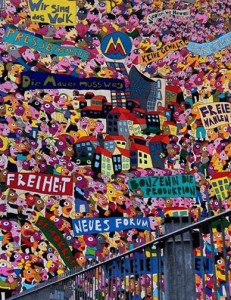 PhD proposals are invited on the following topics:
PhD proposals are invited on the following topics:
- the relationship between globalisation and the fall of state socialism;
- “1989” as a globally interconnected phenomenon;
- the global impact of the collapse of state socialism;
- the impact of the fall of state socialism on memory on a transnational, transregional or global scale;
- other innovative themes which place the fall of state socialism in global perspective.
Applicants wishing to work on any country, world region, or interconnections between regions, or on a global scale, are encouraged to apply. Proposals may address these themes from political, economic, cultural or social perspectives, and may draw their expertise from any discipline in the humanities or social sciences.
The successful candidate will be supervised by Professor James Mark, Principal Investigator with 1989 after 1989. The studentship is anticipated to start between May and September 2015 and is open to UK and EU applicants only. The award will cover tuition fees and provide an annual stipend of £13,863 for three years. More information on this PhD studentship and how to apply can be found on the University of Exeter’s PhD funding webpages.
In addition to this, a further PhD studentship is available on Professor James Mark‘s Arts and Humanities Research Council (AHRC) supported project Socialism Goes Global: Cold War Connections Between the ‘Second’ and ‘Third Worlds’ 1945-1991. This collaborative project brings together the Universities of Exeter, Oxford, Columbia, Leipzig and Belgrade, the Hungarian Academy of Sciences, and University College London to address the relationship between what were once called the ‘Second World’ (from the Soviet Union to the GDR) and the ‘Third World’ (from Latin America to Africa to Asia).
PhD proposals are invited on themes which address any political economic, cultural, or social aspect of this encounter, whether from the viewpoint of one region/country/ institution/group, or with a transregional approach incorporating the perspectives of multiple global actors. For an indication of some potential project areas, see the programme for the project’s first conference.
More information on Socialism Goes Global and how to apply can be found on the University of Exeter’s PhD funding webpages.
[Top]1989 after 1989 Research Fellow Awarded Fritz Stern Dissertation Prize
Posted on 9 December, 2014 in1989 after 1989 Human Rights

Many congratulations to our Research Fellow, Dr Ned Richardson-Little, on being awarded the prestigious 2014 Fritz Stern Dissertation Prize.
He received the award at the 23rd Annual Symposium of the Friends of the German Historical Institute in Washington DC last month, where Richardson-Little also spoke about his dissertation and his research.
 His PhD dissertation: Between Dictatorship and Dissent: Ideology, Legitimacy and Human Rights in East Germany, 1945-1990 (Ph.D. dissertation, University of North Carolina at Chapel Hill, 2013) was praised by the German Historical Institute (GHI) for being an “intellectually challenging and beautifully written study of human rights politics in the German Democratic Republic”. The GHI also commended his work for it’s significant and timely contribution to both historiography on modern Germany and the emerging scholarship on human rights.
His PhD dissertation: Between Dictatorship and Dissent: Ideology, Legitimacy and Human Rights in East Germany, 1945-1990 (Ph.D. dissertation, University of North Carolina at Chapel Hill, 2013) was praised by the German Historical Institute (GHI) for being an “intellectually challenging and beautifully written study of human rights politics in the German Democratic Republic”. The GHI also commended his work for it’s significant and timely contribution to both historiography on modern Germany and the emerging scholarship on human rights.
The GHI’s prize citation reads:
Edward Richardson-Little’s dissertation, “Between Dictatorship and Dissent: Ideology, Legitimacy, and Human Rights in East Germany, 1945-1990,” is an intellectually challenging and beautifully written study of human rights politics in the German Democratic Republic. Upon learning that leaders and supporters of the ruling Sozialistische Einheitspartei Deutschlands (SED) often invoked human rights, one might be tempted to imagine this practice as a cynical use of rhetoric by a dictatorial government to combat a rival Western vision of democracy and capitalism. However, Richardson-Little persuasively demonstrates that the SED and its supporters convinced many religious leaders, intellectuals, and working class supporters that socialism supported an indigenous brand of human rights superior to the individualistic, liberal version offered by the West. Richardson-Little makes excellent use of a wide range of sources from fourteen German archives to argue that, not only was there a thriving debate about human rights in East Germany, but also that citizens used that discourse to express dissent. Quite early, the SED developed its own Marxist conception of human rights to criticize the West, including the dangers of Western imperialism. The East German regime encouraged its citizens to believe that there could be “no human rights without Socialism.” The SED established a Committee for Human Rights, argued for human rights solidarity in the Third World, and used human rights as a basis for international agreements with the West. By the mid-1980s the discourse of human rights fostered by the SED provided peace activists, environmentalists, and advocates of democracy a powerful tool to oppose East German policies as well. The strength of their arguments helps explain the speed of revolutionary impulses by 1989. The SED’s use of human rights discourse, Richardson-Little demonstrates, played a critical role in legitimizing its own downfall. The topic of human rights has received a great deal of scholarly attention from recent historians, largely as part of narratives of the spread of Western values. However, as Richardson-Little points out, contradictions between a rhetoric of human rights and political policies that violate those rights characterized Western powers as well. Historians should be no less willing to accept that contemporaries in East Germany could value human rights, even if their envisioned path to achieving those rights varied significantly from their Western counterparts. In the face of continued debates about the limits of the West’s commitment to human rights, Richardson-Little’s Between Dictatorship and Dissent thus makes a significant and timely contribution, both to the historiography on modern Germany and to the emerging scholarship on human rights.
Richardson-Little will now continues his research with the 1989 after 1989 project at the University of Exeter, where he seeks to complicate the triumphalist narratives of good inevitably overcoming evil, ushering in a unified global human rights culture, by examining the complexity and plurality of human rights in late socialism and the post-socialist world. More information on Dr Richardson-Little research can be found here.
[Top]Transitional Criminal Justice in Post-Dictatorial and Post-Conflict Societies
Posted on 3 December, 2014 in1989 after 1989 Human Rights Transitional justice

Raluca Grosescu‘s co-edited volume “Transitional Criminal Justice in Post-Dictatorial and Post-Conflict Societies” is now available as part of Intersentia’s Series on Transitional Justice.
Edited alongside Agata Fijalkowski, a Senior Lecturer in Law at Lancaster University, the volume considers the important and timely question of criminal justice as a method of addressing state violence committed by non-democratic regimes. Its main objectives concern a fresh, contemporary, and critical analysis of transitional criminal justice as a concept and its related measures, beginning with the initiatives that have been put in place with the fall of the Communist regimes in Europe in 1989.
The collection argues for a re-thinking and re-visiting of filters scholars use to interpret the main issues of transitional criminal justice. Such things as: the relationship between judicial accountability, democratisation and politics in transitional societies; the role of successor trials in re-writing history; the interaction between domestic and international actors and specific initiatives in shaping transitional justice; and the paradox of time in enhancing accountability for human rights violations. In order to accomplish this, the volume considers cases of domestic accountability in the post-1989 era, from different geographical areas, such as Europe, Asia and Africa, in relation to key events from various periods of time. In this way the approach, which investigates space and time-lines in key examples, also takes into account a longitudinal study of transitional criminal justice itself.
Transitional Criminal Justice in Post-Dictatorial and Post-Conflict Societies will be available from Intersentia as part of their Series on Transitional Justice.
[Top]‘Death to fascism, freedom to expression!’ – The Post-Yugoslav Media and Freedom of Speech
Posted on 3 November, 2014 in1989 after 1989 End of Yugoslavia Human Rights

By Ljubica Spaskovska
The transition to democracy should have liberated the media in the former Yugoslav states, but in many ways the situation has actually gotten worse.
‘In these times/when everything is silent/In these times/I say – freedom/ And I see fear…’
This verse from the song entitled ‘Freedom’ is one of the tracks from an album by the Macedonian band ‘Reporters’ made up exclusively of journalists of different ethnic backgrounds. Under the slogan ‘Solidarity for freedom’, the Independent trade union of journalists and media workers, with the support of the US Embassy launched a campaign meant to incite a debate on freedom of speech, on the state of the media in Macedonia and solidarity among journalists. Over the past few weeks, both Macedonia’s and Serbia’s Independent Journalists’ Associations (members of the International Federation of Journalists) have raised concerns about similar phenomena through calls for a public hearing on media freedom or through the organisation of debates, conferences and concerts.
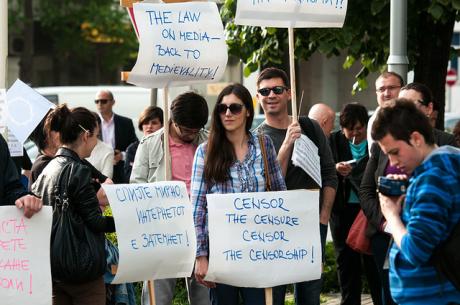
Indeed, the 2014 EU progress reports for all of the post-Yugoslav states aspiring to EU accession (Bosnia-Herzegovina, Montenegro, Serbia, Kosovo, Macedonia) underline a trend of serious deterioration of media freedom. Almost quarter of a century after the disintegration of Yugoslavia and the introduction of electoral, multi-party democracy, these societies have been witnessing a progressive narrowing down of public, intellectual and media spaces for free debate and reporting. Political and financial pressures, intimidation and threats against journalists and editors in Bosnia, self-censorship, threats and violence against journalists in Serbia, Montenegro and Kosovo, and government influence on media exercised through state-financed advertising in Macedonia have been observed in a context of a scarcity of real commitment on the part of political elites to tackle this problem and take the recommendations from the progress reports seriously.
Over the years, different governments have managed to blur the line between the ruling party/coalition and the state and to deprive state institutions of their independence. Moreover, they have turned an increasing number of media outlets into channels for dissemination of their political ideology or attacks on political opponents. For instance, the State Department Macedonia Country Report on Human Rights Practices for 2013 noted that members of the Association of Journalists of Macedonia reported pressures ‘to adopt a pro-government viewpoint in their reporting or lose their jobs.’
In Macedonia, further grievances were aroused by the detention and conviction of journalist Tomislav Kežarovski for revealing the identity of a protected witness in a story written in 2008. Civil society activists, local journalist associations and opposition leaders have constantly referred to reports by international bodies and governments that had condemned the trial and Kežarovski’s imprisonment in order to give legitimacy to their protest, albeit to little avail.
Moreover, the State Department Country Report lists Kežarovski’s case in the section entitled ‘Political Prisoners and Detainees’. The OSCE Representative for the Freedom of the Media, as well as the European Federation of Journalists similarly condemned the long sentence. Hence, it comes as no surprise that in the 2014 World Press Freedom Index Macedonia sits in 123rd place and has never been so low in the Index (the lowest in comparison to the other former Yugoslav states).
However, the state of the media is only a symptom of wider societal phenomena such as growing intolerance toward ‘oppositional’ voices and certain frozen narratives which seek to uncritically glorify the nation, the state, the ruling ideology and demonize the socialist/Yugoslav past. Croatia and Slovenia are the only two former Yugoslav republics which are members of the European Union. Although considerably higher on the World Press Freedom Index, neither Slovenia nor Croatia have been immune to the (re)establishment of a certain dogmatism in interpreting or discussing about the past.
A case in point is the recent decision of Croatian President Ivo Josipović to fire his main analyst professor Dejan Jović for an article in the academic journal Political Thought. Entitled ‘Only in myths every nation desires its own state’ and comparing the Scottish independence referendum and the Yugoslav referenda of the early 1990s, Jović argued that the latter were illiberal and did not allow for a genuine debate and consideration of all political opinions and visions for Yugoslavia’s future.
Similarly, the MPs of the conservative Slovenian Democratic Party (SDS) proposed a dismissal of the president of the Slovenian national assembly Dr. Milan Brglez for qualifying Yugoslavia in an interview as a state that had credibility and prestige in the international community and that the Slovenian independence in that sense was a step backwards.
Why, a quarter of a century after the first multi-party elections in the former Yugoslavia, are there still certain dogmatic ‘truths’ in most of the successor states, where freedom of expression is not an accomplishment, but, rather, something yet to be realised?
An obvious reason which is often evoked as the main factor is the socialist past itself. However, this can only offer a partial explanation and it could be counter-productive, as it fails to put the burden of responsibility on contemporary policy-makers and elites. Moreover, from 1950 practices of pre-censorship had been abolished in socialist Yugoslavia. It was the public prosecutor who could act only ex-post facto, after a broadcast, publication or film presentation. By the mid-1980s, the Yugoslav media network was significantly fragmented, decentralised, yet numerically impressive.
In 1987, Yugoslavia had 2,825 newspapers and 202 radio and TV stations. Hence, it was virtually impossible to sanction all acts which were classified as ‘verbal crime’ under the notorious ‘Article 133’ which criminalised acts of ‘hostile propaganda’, but was also meant to curb nationalist discourse, channelling what Lenard Cohen identified as ‘Yugoslav communism’s strong antipathy to overt nationalist tactics’.[1] Moreover, the 1980s saw the reinvigoration of the debate on freedom of speech and on the abolishment of the verbal crime. Although restrained, debate did occur in different fora.
For instance, in 1981 the president of the Federal Court in an article in a law journal acknowledged that the formulation of ‘Article 133’ was not precise, while at the 1983 conference of Yugoslav criminologists several professors of law called for the repeal of the article.[2] Several years later, as a young journalist in one of the principal magazines of the League of Socialist Youth, Dejan Jovic argued that the organisation (which in fact financed the magazine) should be abolished [3]. Back then, he was not sacked for his opinion.
Twenty-five years later, both old and new generations of journalists, intellectuals, students and activists are fighting battles which would have normally belonged to a distant past. When on 9 May last year, on the occasion of Europe Day, representatives of the ‘Front for Freedom of Expression’ gathering a number of civil society organizations and initiatives staged a protest in front of the seat of the delegation of the European Union to Macedonia, they chose as their slogan a creative remake of an old motto of the partisan resistance movement: ‘Death to fascism, freedom to expression!’.
References:
[1] Lenard Cohen, The Socialist Pyramid Elites and Power in Yugoslavia(Oakville/New York/London: Mosaic Press, 1989), p.445.
[2] Yugoslavia: Prisoners of Conscience (London: Amnesty International Publications, 1985), p.29.
[3] Dejan Jović, ‘Kad bi SSOJ postojao, trebalo bi ga ukinuti (1)’ Polet 402, 10.2.1989.
[Top]Introductory Seminar
Posted on 19 May, 2014 in1989 after 1989
Monday 2nd June, 3pm
Amory C417, Streatham Campus, The University of Exeter
Work began on the 1989 after 1989 project in January 2014 and the team of six researchers will be presenting their work at an Introductory Seminar on Monday 2nd June at 3pm in Amory C417. All are welcome to attend.
The team are particularly interested in promoting interdisciplinary research and creating links with those interested in understanding this moment of major political, economic and cultural transformation from different regional perspectives – Germany to Kazakhstan and from Latin America to sub-Saharan Africa.
The following research projects will be presented:
Dr Raluca Grosescu – Transitional Justice in Post-Dictatorial Eastern Europe and Latin America
Dr Nelly Bekus – The After-Life of the Socialist Legacy in Post-Soviet Capital Cities
Dr Ned Richardson-Little – Human Rights in the Global 1989
Dr Ljubica Spaskovska – The End of Yugoslavia as a Global Project
Anna Calori – Experience and Understanding of Economic Transformation in States in the Former Yugoslavia
For more information about this seminar please contact Natalie Taylor, Project Co-ordinator – N.H.Taylor@exeter.ac.uk
[Top]





